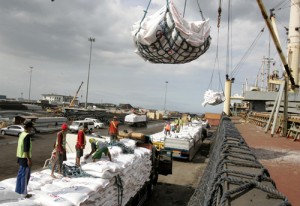The government will soon start discussions on the volume of rice to be imported this year, with the private sector kept out of the transactions, the Department of Agriculture (DA) said on Thursday.
Agriculture Secretary Proceso Alcala told reporters that a Cabinet level meeting is slated for next week to evaluate the rice supply situation in the country after a series of typhoons last year caused massive damage on farm crops.
“Right now, we still don’t have a specific target volume [for rice imports]. But we need to do this to keep prices stable,” Alcala said, noting the DA’s shortfall in rice self-sufficiency targets and the unusual withdrawal of rice stocks in typhoon-hit areas.
The DA chief also stressed that rice importation will be done under a government-to-government arrangement.
“After the typhoons, majority of the rice stocks are in the hands of the private sector. If we ever need to import rice, the government will have to step forward,” he said.
“What I am sure of is that we will not import more than what we need and it should arrive before the start of the lean season in June,” the DA chief added.
Alcala said that the interagency National Food Authority (NFA) Council would make a recommendation on the quantity of rice that needs to be imported.
“Part of the evaluation is how the government will utilize the omnibus volume of the minimum access volume [MAV],” he added.
Earlier, the NFA opened to private sector the importation of 163,000 metric tons of rice under the country-specific-quota (CSQ) allocation of MAV.
Importation of rice shall only be from the four specified source countries—comprising 98,000 MT from Thailand, 25,000 MT from China, 25,000 MT from India, and 15,000 MT from Australia. Any importation outside the CSQ shall be prohibited.
MAV refers to the minimum volume of farm produce, such as rice, allowed to enter into the Philippines at reduced tariffs.
At present, the Philippines is allowing 350,000 TM of rice to enter the country annually at reduced tariff rate of 40 percent.
Of the total MAV volume, some 163,000 MT is allocated for importation by the private sector, while the remaining 187,000 MT, or the so-called omnibus volume of MAV, was reserved for possible procurement by the government.
RICE SELF-SUFFICIENCY
Meanwhile, Alcala said the DA is evaluating the government’s rice self-sufficiency program after falling short of the target last year.
Despite unprecedented increase in rice production last year because of massive development in the rice ecosystems, particularly in previously non-irrigated lands, the Philippines was only able to reach 98 percent rice sufficiency levels.
“As of now, we are reevaluating the targets. But if this [rice self-sufficiency target] is really an unreachable star, even if we did fine-tuning, then what do we do?” he said.
Nevertheless, Alcala noted that over the past three years, the country saw an increase in palay (unmilled rice) production, from 15.77 million MT in 2010, to 16.68 million MT in 2011, and 18.03 million MT in 2012. All these are well within the targets earlier set out by the Food Self Sufficiency Program of the DA, when it was prepared in the latter part of 2010 up to the earlier part of 2011.
In 2013, despite some 25 typhoons that entered the Philippine Area of Responsibility, the country’s full year palay production hit record 18.44 million MT, or 2.3 percent higher than the 18.03 million MT in 2012.


